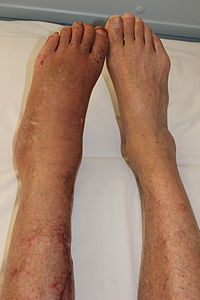
Photo from wikipedia
A retrospective data analysis of 159 complex regional pain syndrome (CRPS) patients (n = 116 women, 73.0%, mean age 60.9 ± 14.4 years; n = 43 men, 27.0%, mean age… Click to show full abstract
A retrospective data analysis of 159 complex regional pain syndrome (CRPS) patients (n = 116 women, 73.0%, mean age 60.9 ± 14.4 years; n = 43 men, 27.0%, mean age 52.3 ± 16.7 years) was performed from 2009 to 2020. The right side was affected in 74 patients (46.5%), the left in 84 patients (52.8%), and 1 patient (0.7%) developed a bilateral CRPS. Data were analyzed for the frequency and distribution of symptoms. The number of reduction maneuvers and the number of Budapest criteria were compared in relation to the severity of CRPS. Hand and wrist (n = 107, 67.3%), followed by foot and ankle (n = 36, 22.6%) and other locations (n = 16, 10.1%) were mainly affected by CRPS. The main causes included direct trauma (n = 120, 75.5%), surgery without previous trauma (n = 25, 15.7%), other causes (n = 9, 5.7%), and spontaneous development (n = 3, 1.9%); there was also missing documentation (n = 2, 1.3%). The most common symptoms were difference in temperature (n = 156, 98.1%), limitation of movement (n = 149, 93.7%), and swelling (n = 146, 91.8%). There was no correlation between the number of reduction maneuvers and the number of Budapest criteria. In summary, patients with the following constellation are at increased risk of CRPS: a female, over 60 years old, who has fallen and has sustained a fracture in the hand or wrist with persistent pain and has been immobilized with a cast for approx. 4 weeks.
Journal Title: International Journal of Environmental Research and Public Health
Year Published: 2023
Link to full text (if available)
Share on Social Media: Sign Up to like & get
recommendations!